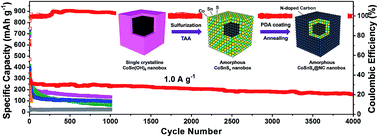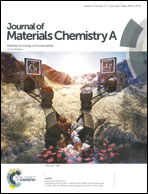Achieving ultralong life sodium storage in amorphous cobalt–tin binary sulfide nanoboxes sheathed in N-doped carbon†
Abstract
The interest in Na-ion batteries (NIBs) is growing exponentially since Na is more abundant and affordable than Li for large-scale energy storage applications. However, the lack of truly durable and high-capacity electrode materials still remains a key bottle-neck issue for the development of practical NIBs. In this work, we report the rational design of an ultra-long life anode material for NIBs by integrating the structural merits of hollow nanostructures, carbon nanocoating and amorphous structures together into a binary metal sulfide system. Amorphous CoSnSx nanoboxes sheathed in N-doped carbon are yielded by templating against single-crystalline CoSn(OH)6 nanoboxes, followed by polymer nanoplating and carbonization. The synergy of diverse structural features enables a robust structure and fast reaction kinetics for Na storage in the CoSnSx@NC anode, leading to an exceptionally long cycle life of 4000 cycles with very slow capacity loss (0.0075% per cycle) and high power output. The full cells assembled from the Na3V2(PO4)3/C cathode and the CoSnSx@NC anode deliver a high energy density of up to 86.6 W h kg−1, as well as good capacity retention at high current rate.



 Please wait while we load your content...
Please wait while we load your content...